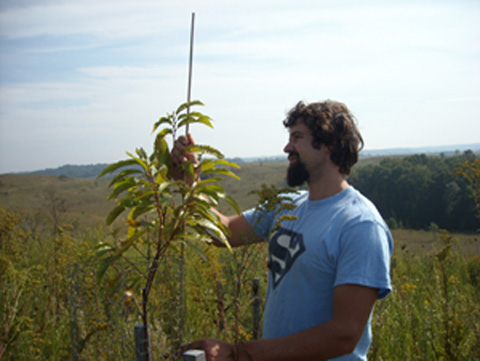
Keith Gilland has participated in an effort, spearheaded by the American Chestnut Foundation, to breed and repopulate a blight-resistant chestnut tree in the United States. (Photo credit: Julia Chapman at Jockey Hollow Wildlife Management Area)
By Philip Barnes
Keith Gilland ’13Ph.D. is working to bring life back to old coal mining sites in Ohio by reintroducing a long-lost species, the American chestnut tree. This “redwood of the east” used to cover 25 percent of the forests in the eastern United States. Save for a few survivors, the tree has been extinct from the state since the early 1930s, a victim of blight.
“Reintroducing the American chestnut is a learning experience in itself,” Gilland says. “They disappeared before people did what we call modern ecology, so no one really knows anything about growing them.”
But the American Chestnut Foundation has been determined to revive the species, says Dr. Brian McCarthy, Professor of Environmental & Plant Biology who was Gilland’s adviser.
- Read Gilland’s dissertation, “Early Successional Processes of Experimentally-Reclaimed Mine Sites in Eastern Ohio and the Restoration of American Chestnut.”
“The foundation is finishing up a 30-year breeding program to create a blight-resistant tree,” McCarthy says. “They’ve finally done it. I thought about putting chestnut trees out on reclaimed strip mines, killing two birds with one stone in a double-barreled project.”
Gilland first met McCarthy eight years ago in Wisconsin, where a rare 100-acre strain of chestnut trees avoided the blight. In fall 2008, the student first started growing American chestnuts on strip mines.
So far Gilland has planted more than 5,000 American chestnuts on old coal mines in locations such as Zanesville and Cadiz, Ohio. It is a meticulous process. He monitors tree growth on a monthly basis and uses small plastic tubes to surround the saplings, protecting them from small rodents and deer. About half have survived.
“I went into the project thinking that every one of the seedlings could die. I’m actually very happy with our progress and what I’ve learned,” he says.
Through trial-and-error, Gilland discovered that chestnuts prefer open areas with little shade. They also tolerate dry soils, making them a perfect candidate for mine site reclamation. Sometimes, however, growing them just isn’t possible.
“On some of the older sites we’ve worked at, mining companies just left giant, acre-wide holes in the middle of forests,” Gilland says. “Fifty years later, it still looks like the surface of the moon. The remaining soil is too acidic, even for the chestnut.”
Due to the 1977 Mine Site Reclamation Act, coal companies are required to cover at least 80 percent of their former mining sites with vegetation. Many companies have used quick-growing invasive grass species, which aren’t particularly picky about soil type. Truckloads of sandstone, stockpiled topsoil, and “whatever else is there” are used to fill in holes, Gilland says. The mix is then compressed by giant bulldozers, and the nutrient-rich soil that was once on top often ends up far beneath the ground. The sites can remain as blotchy patches of grassland for decades, he says.
Because planting trees may be more cost-effective and yield better results, coal companies are funding studies on ideal growing conditions. Gilland is researching the benefits of introducing root fungi to help chestnuts take in more nutrients from soil, though his success thus far has been limited.
“With trees, there’s no need for fertilization or expensive hydroseeding [mixing seed and mulch for faster growth],” says Gilland. “There just needs to be a policy change, a new set of government guidelines and inspection based on tree survival over a long term.”
Why choose the American chestnut over an oak or elm for such reclamation work? While oaks generate a varying number of acorns per year, Gilland’s surviving trees produce a steady annual supply of carb-heavy chestnuts, which are easier for wildlife to digest.
And while there have been some challenges along the way, the researchers are also encouraged by their successes. A big comeback for the chestnut just might be around the corner.
“A lot of my trees look totally awesome now,” Gilland says. “Many of the ones I planted when I was an undergrad at Miami University are now 10 to 15 feet tall.”
Gilland earned a Ph.D. in Environmental and Plant Biology from the College of Arts & Sciences Ohio University.
This article appears in the special graduate student edition of Ohio University’s Perspectives magazine, published in spring 2013.


















Comments